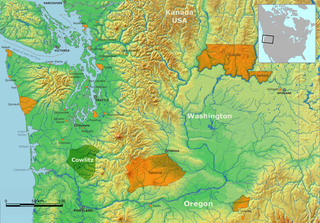Chehalis people may refer to:
- Lower Chehalis people
- Upper Chehalis people
- Confederated Tribes of the Chehalis Reservation, a federally recognized tribe of Upper Chehalis and Lower Chehalis people
- Sts'ailes people, formerly called the Chehalis
Chehalis people may refer to:

Moclips is an unincorporated community and census-designated place (CDP) in Grays Harbor County, Washington, United States. The population was 211 at the 2020 census. It is located near the mouth of the Moclips River.
Chehalis may refer to:

The Chehalis River is a river in Washington in the United States. It originates in several forks in southwestern Washington, flows east, then north, then west, in a large curve, before emptying into Grays Harbor, an estuary of the Pacific Ocean. The river is the largest solely contained drainage basin in the state.

The term Cowlitz people covers two culturally and linguistically distinct indigenous peoples of the Pacific Northwest; the Lower Cowlitz or Cowlitz proper, and the Upper Cowlitz / Cowlitz Klickitat or Taitnapam. Lower Cowlitz refers to a southwestern Coast Salish people, which today are enrolled in the federally recognized tribes: Cowlitz Indian Tribe, Quinault Indian Nation, and Confederated Tribes of the Chehalis Reservation. The Upper Cowlitz or Taitnapam, is a Northwest Sahaptin speaking people, part of the Confederated Tribes and Bands of the Yakama Nation.

The Shoalwater Bay Indian Tribe is a federally recognized Native American tribe in Pacific County, Washington, United States. The tribe is descended from the Lower Chehalis and the Willapa (Shoalwater) Chinook peoples. In 2016, the tribe had 373 enrolled citizens.

The Quinault are a group of Native American peoples from western Washington in the United States. They are a Southwestern Coast Salish people and are enrolled in the federally recognized Quinault Tribe of the Quinault Reservation.

The Chinookan languages are a small family of extinct languages spoken in Oregon and Washington along the Columbia River by Chinook peoples. Although the last known native speaker of any Chinookan language died in 2012, the 2009-2013 American Community Survey found 270 self-identified speakers of Upper Chinook.

The Stó꞉lō, alternately written as Sto꞉lo, Stó꞉lô, or Stó꞉lõ, historically as Staulo, Stalo or Stahlo, and historically known and commonly referred to in ethnographic literature as the Fraser River Indians or Lower Fraser Salish, are a group of First Nations peoples inhabiting the Fraser Valley and lower Fraser Canyon of British Columbia, Canada, part of the loose grouping of Coast Salish nations. Stó꞉lō is the Halqemeylem word for "river", so the Stó꞉lō are the river people. The first documented reference to these people as "the Stó꞉lō" occurs in Catholic Oblate missionary records from the 1880s. Prior to this, references were primarily to individual tribal groups such as Matsqui, Ts’elxweyeqw, or Sumas.

The Confederated Tribes of the Chehalis Reservation is a federally recognized tribe located in Southwest Washington. They are a part of the Northern Straits branch Central Coast Salish peoples of Indigenous peoples of the Northwest Coast.
Cowlitz, also known as Cowlitz Salish, is a Tsamosan language of the Coast Salish family of Salishan languages. It was spoken by the Lower Cowlitz people of the Cowlitz Indian Tribe and is spoken today by both Lower and Upper Cowlitz people. Although it went dormant in the 1960s, it is being revitalized by the Cowlitz Tribe.
The Sts'ailes are an indigenous people from the Lower Mainland region of British Columbia, Canada.

The Satsop River is a stream in the U.S. state of Washington. It has three main tributary forks, the East Fork, West Fork, and Middle Fork Satsop Rivers. The main stem Satsop River is formed by the confluence of the West and East Forks. The Middle Fork is a tributary of the East Fork. The three forks are much longer than the main stem Satsop itself, which flows south from the confluence only a few miles to join the Chehalis River near Satsop, Washington. Other significant tributaries include the Canyon River and Little River, both tributaries of the West Fork Satsop, and Decker Creek, a tributary of the East Fork Satsop River. The Satsop River's major tributaries originate in the Olympic Mountains and its southern foothills, the Satsop Hills, within Grays Harbor and Mason counties. Most of the Satsop River's watershed consists of heavily wooded hill lands. The upper tributaries extend into Olympic National Forest, approaching but not quite reaching Olympic National Park.
The Willapa or Willoopah, also known as Kwalhioqua / Kwalhiokwa, were a Northern Athapaskan-speaking people in southwestern Washington, United States. Their territory was the valley of the Willapa River and the prairie between the headwaters of the Chehalis and Cowlitz Rivers.
Confederated Tribes may refer to a number of associations of Indigenous peoples in the American part of the Pacific Northwest:

The Salish peoples are indigenous peoples of the American and Canadian Pacific Northwest, identified by their use of the Salishan languages which diversified out of Proto-Salish between 3,000 and 6,000 years ago.
Upper Chehalis is a member of the Tsamosan (Olympic) branch of the Coast Salish family of Salishan languages. Thompson's 1979 classification lists Upper Chehalis as more closely related to the Cowlitz language than it is to Lower Chehalis.
Lower Chehalis is a member of the Tsamosan branch of the Coast Salish family of Salishan languages. In some classifications, Lower Chehalis is placed closer to Quinault than it is to Upper Chehalis. It went extinct in the 1990s.
The Chehalis language is a collective expression regarding two languages, Upper Chehalis language and Lower Chehalis language. Both are members of the Tsamosan (Olympic) branch within the Coast Salish subfamily of the Salishan language family.
The Lower Chehalis are a Southwestern Coast Salish people Indigenous to Washington state. Today, the Lower Chehalis do not maintain a distinct sovereign identity, although people of Lower Chehalis descent are enrolled in several federally recognized tribes, such as the Shoalwater Bay Indian Tribe, Confederated Tribes of the Chehalis Reservation, and the Quinault Indian Nation.
The Upper Chehalis are a Southwestern Coast Salish people Indigenous to Washington state.